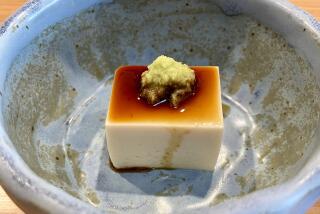Another strange vision from a butoh tradition
- Share via
Butoh, that decidedly anti-Western, post-Hiroshima dance genre known for its enigmatic, bizarre and impenetrable productions, has become over the years, if not exactly pop, then at least more accessible, thanks to the all-male stylings of the Japanese troupe Sankai Juku. Founded 31 years ago by Ushio Amagatsu and based in Paris since 1980, the company has since presented its hairless, naked bodies bathed in white chalk dust to more than 700 cities in 41 countries.
No strangers to Los Angeles, the seven-member company opened a two-night run Friday at UCLA’s Royce Hall with Amagatsu’s latest opus, “Kagemi: Beyond the Metaphors of Mirrors.” Inspired by the work of Riho Senba, a master of ikebana (Japanese flower arranging), the 90-minute piece unfolded over seven scenes, the set a glorious tableau of dozens of giant white lotus leaves that rose from the floor and floated from the ceiling as if a gift from God.
Or your local Ecstasy dealer. Seriously, the beauty of the sacred blossoms married with Amagatsu’s Wilson-esque lighting and a taped score by Takashi Kako and Yoichiro Yoshikawa -- an East-meets-West sensibility dripping with koto and piano noodlings, pulsing percussion, electric guitar and New Age synthesizers -- made a perfect backdrop for the choreographer’s ascetic movement vocabulary: in this case, butoh lite.
Gone are the slow-as-molasses inchings of a squirmy toe, the tormented lift of a leg or adagio-paced writhings that are hallmarks of the art form as practiced, say, by local butoh virtuoso Oguri. Instead there is 56-year-old Amagatsu, clad in an ecru tunic (he also designed the catwalk-worthy costumes), opening the work with a solo referencing Martha Graham one moment, the Statue of Liberty the next, an arm raised in triumph, head cocked while beseeching with come-hither hand curlings.
“Kagemi,” which roughly translates as “seeing one’s shadows,” plumbs the concept of mirror imagery as the flowers ascend to reveal two trios of crouched performers, their undulating wrists conjuring rippling waters. Rising like alien cheerleaders, their skirts swirl, releasing clouds of languidly wafting dust. Faces contort with silent screams before bodies skitter and bounce. Knees rubbed raw, the sextet then forays into frenzied moves.
This dawn of creation continues with an orange glow revealing a jaunty mirror routine oddly reminiscent of Harpo and Groucho Marx that seamlessly bleeds into a series of angst-shrouded gesticulations and circle spinning. Visually stunning, the scenes, however, feel devoid of struggle. Which isn’t to say there isn’t profundity or spirit on stage, as dancers twist about in distressed gowns and smear their faces with blood-red greasepaint.
Peace returns in the amber-hued finale, where arched torsos and sweetly fidgeting hips have a purging, meditative quality. The flowers have opened and closed, the seraphs and devils come and gone. As the blooms descend from above, another day has passed in Amagatsu’s lotus land.
Whether you’re with him or not, his dreamy apparition cannot be denied.
More to Read
The biggest entertainment stories
Get our big stories about Hollywood, film, television, music, arts, culture and more right in your inbox as soon as they publish.
You may occasionally receive promotional content from the Los Angeles Times.










